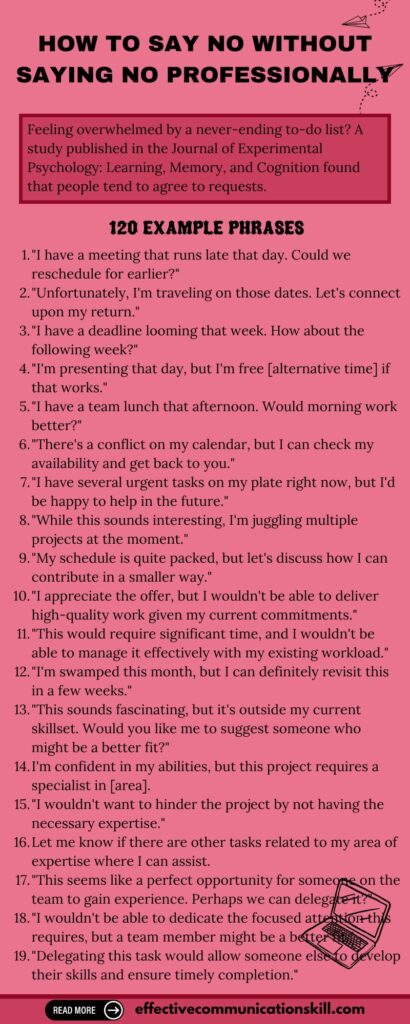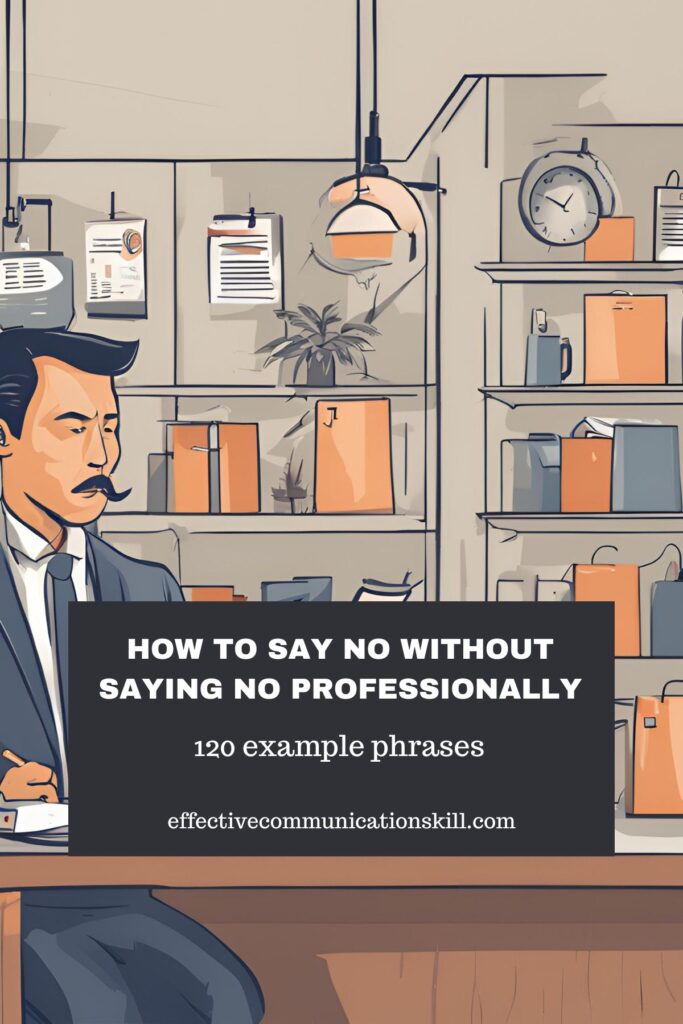How to Say No Without Saying No Professionally
Feeling overwhelmed by a never-ending to-do list? A study published in the Journal of Experimental Psychology: Learning, Memory, and Cognition found that people tend to agree to requests more readily than they should. This can lead to burnout, missed deadlines, and ultimately, a decline in the quality of work.
But what if there was a way to politely decline requests while maintaining positive relationships and a healthy workload? Enter the art of the artful decline – a strategic approach to saying “no” that benefits you and your colleagues.
HOW TO PROFESSIONALLY SAY SOMEONE IS NO LONGER WITH THE COMPANY – By mastering this skill, you can transform a potential source of stress into an opportunity to manage expectations, prioritize effectively, and showcase your professionalism.

How to Say No Without Saying No Professionally
Saying no effectively goes beyond a simple “no.” Here are five key strategies to express your limitations professionally:
- Express Appreciation and Explain Your Constraints: “Thank you for thinking of me for this project. Unfortunately, my current workload won’t allow me to take on additional commitments at this time.”
- Offer an Alternative: “I’d love to help with the report, but I’m swamped this week. Perhaps I can contribute to the next section?”
- Suggest a More Suitable Candidate: “While I’m not the best fit for this task, I can recommend [colleague’s name] who has expertise in this area.”
- Propose a Timeline Shift: “I’m very interested in participating, but I wouldn’t be able to dedicate the necessary time until [date]. Would a later deadline be feasible?”
- Be Clear and Concise: “I appreciate the offer, but I must decline due to current commitments.”
100+ Ways to Professionally Decline a Request Without Saying No
Here’s a list of other professional and polite responses to say no without saying No for different situations:
Schedule Conflicts
- “My calendar is full this week, but let’s revisit next week.”
- “I have a prior commitment, but perhaps we can reschedule?”
- “Unfortunately, I’m unavailable on those dates. Could we try [alternative dates]?”
- “Would a different time slot work better for you, perhaps in the afternoon?”
- “I’m booked that day, but I’m free on [alternative date]. Would that work?”
- “I have a meeting that runs late that day. Could we reschedule for earlier?”
- “Unfortunately, I’m traveling on those dates. Let’s connect upon my return.”
- “I have a deadline looming that week. How about the following week?”
- “I’m presenting that day, but I’m free [alternative time] if that works.”
- “I have a team lunch that afternoon. Would morning work better?”
- “There’s a conflict on my calendar, but I can check my availability and get back to you.”
Workload Limitations
- “My current workload wouldn’t allow me to dedicate the necessary time to this project.”
- “I wouldn’t be able to give this project the full attention it deserves right now.”
- “Unfortunately, I’m stretched thin with other priorities at the moment and wouldn’t be able to take this on.”
- “Taking on this additional task would exceed my current capacity.”
- “I wouldn’t be able to meet the deadlines comfortably with my current workload.”
- “I have several urgent tasks on my plate right now, but I’d be happy to help in the future.”
- “While this sounds interesting, I’m juggling multiple projects at the moment.”
- “My schedule is quite packed, but let’s discuss how I can contribute in a smaller way.”
- “I appreciate the offer, but I wouldn’t be able to deliver high-quality work given my current commitments.”
- “This would require significant time, and I wouldn’t be able to manage it effectively with my existing workload.”
- “I’m swamped this month, but I can definitely revisit this in a few weeks.”
Lack of Expertise
- “While I appreciate the offer, this project falls outside my area of expertise.”
- “I wouldn’t be the best fit for this task due to my limited experience in [area].”
- “Perhaps someone with a background in [area] would be more suitable for this project.”
- “I’m happy to connect you with a colleague who has expertise in this specific area.”
- “This would be a great learning opportunity for someone on the [team name] who specializes in [area].”
- “My knowledge in [area] is limited, but I can help you find someone on the team who’s more qualified.”
- “I’m more focused on [your area of expertise] currently, but I’m happy to learn more if needed.”
- “This sounds fascinating, but it’s outside my current skillset. Would you like me to suggest someone who might be a better fit?”
- I’m confident in my abilities, but this project requires a specialist in [area].
- “I wouldn’t want to hinder the project by not having the necessary expertise.”
- Let me know if there are other tasks related to my area of expertise where I can assist.
Delegation
- “I’d be happy to delegate this task to [colleague’s name] who has experience in this area.”
- “Perhaps [colleague’s name] would be a better fit for this project due to their expertise.”
- “Would it be possible to delegate this to a team member who can focus solely on it?”
- “I can help you identify someone on the team who might be a better fit for this specific task.”
- “Let’s discuss delegating this to free up time for everyone on the project.”
- “I have a heavy workload at the moment, but I can delegate this to a team member who has more availability.”
- “While I can’t take this on myself, I can delegate it to someone who can ensure it’s completed efficiently.”
- “This seems like a perfect opportunity for someone on the team to gain experience. Perhaps we can delegate it?”
- “I wouldn’t be able to dedicate the focused attention this requires, but a team member might be a better fit.”
- “Delegating this task would allow someone else to develop their skills and ensure timely completion.”
- “Let’s explore delegating options to best utilize everyone’s strengths on the team.”
Future Availability
- “I’d be happy to help with similar projects in the future when my schedule allows.”
- “This sounds interesting, but I won’t be able to contribute until [date].”
- “While I can’t commit now, keep me in mind for future opportunities like this.”
- “I’m unavailable at the moment, but please reach out if the need arises again in the future.”
- “Let’s revisit this closer to the deadline when I have a clearer picture of my workload.”
- “My schedule is quite booked at the moment, but I might have more flexibility in [future timeframe].”
- “I wouldn’t be able to dedicate the time that I need right now, but perhaps in a few weeks.”
- “While I can’t commit today, I’ll keep an eye on my schedule and let you know if my availability changes.”
- “This sounds like a valuable project, and I’d love to be involved when my current commitments ease up.”
- “I appreciate you thinking of me, and I’ll be sure to reach out if my availability changes in the future.”
- “Unfortunately, I can’t contribute right now, but I’d be happy to help with similar projects down the line.”

Resource Constraints
- “Unfortunately, we don’t have the necessary resources to take on this project at this time.”
- “This project sounds valuable, but our team’s resources are currently stretched thin.”
- “We’d love to help, but securing the necessary resources for this project would be challenging right now.”
- “While we’re interested, this would require additional resources that are currently unavailable.”
- “Let’s revisit this request when we have a clearer picture of our resource availability.”
- “We’re committed to existing projects, and taking this on might strain our resources.”
- “Our budget wouldn’t allow us to dedicate the necessary resources to this project at this time.”
- “We appreciate the offer, but fulfilling this request would require additional resources beyond our current capacity.”
- “Perhaps there are alternative solutions or a smaller scope that would better align with our current resources.”
- “We’d be happy to explore this further once we have a better understanding of the resource requirements.”
Clarification Needed
- “I’d be happy to consider this further, but I need some clarification on the project scope.”
- “Could you provide more details about the project timeline and expectations before I commit?”
- “I’m interested, but I have a couple of questions about the project goals before I can give you a definitive answer.”
- “To best assess my availability, I’d need a clearer understanding of the time commitment involved.”
- “Having more information about the resources available for this project would be helpful in making a decision.”
- “I’d appreciate some additional details about the project deliverables before I move forward.”
- “To give you a more informed response, I’d need some clarification on the project budget.”
- “Could you elaborate on the specific skills and experience required for this project?”
- “Having a clearer picture of the project timeline would be helpful in assessing my capacity.”
- “Once I have a better understanding of the project’s goals, I can determine if it aligns with my current priorities.”
Policy Restrictions
- “Unfortunately, company policy restricts me from participating in projects like this.”
- “While I’m interested, this request might not comply with certain company policies.”
- “Our company policies might prevent us from moving forward with this project at this time.”
- “Let’s explore alternative approaches that would adhere to all relevant company policies.”
- “I’d be happy to help if we can find a solution that aligns with company policy guidelines.”
- “There might be policy restrictions that would prevent us from taking on this specific project.”
- “We value your request, but it’s important to ensure all our actions comply with company policy.”
- “Company policy might require additional approvals before we can proceed with this request.”
- “I’m happy to champion this internally, but we’ll need to ensure it adheres to company policies.”
- “Understanding the specific policy limitations would help us determine the best course of action.”
Alternative Solutions
- “While I can’t take this on myself, I can suggest some alternative solutions that might be helpful.”
- “Perhaps there’s a different approach that would better suit my current workload and achieve similar results.”
- “I’m unable to commit at this time, but I can offer some suggestions that might be a better fit.”
- “Let’s brainstorm some alternative solutions that wouldn’t require my direct involvement.”
- “I’d be happy to connect you with someone who might be a better resource for this specific request.”
- “While I can’t fulfill this request, I can offer some guidance on alternative approaches.”
- “There might be a different way to achieve the desired outcome that aligns better with my current availability.”
- “I appreciate the offer, but perhaps there’s a way to scale back the request or break it down into smaller tasks.”
- “I can’t commit to this project, but I’m happy to brainstorm alternative solutions that might be more feasible.”
- “While I can’t fulfill this request directly, I can offer some resources or connections that might be helpful.”
Prioritization
- “I appreciate the request, but I have other priorities that require my immediate attention.”
- “Unfortunately, my current workload requires me to prioritize other projects at this time.”
- “Taking on this request would require shifting my focus away from other pressing deadlines.”
- “Let’s revisit this when I’ve completed my current priorities and have a clearer picture of my availability.”
- “I’d be happy to help once I’ve addressed my most urgent commitments.”
- “While this sounds valuable, I have other priorities that I need to focus on right now.”
- “Understanding the relative urgency of this request would help me determine how I can best allocate my time.”
- “Due to my current workload, I wouldn’t be able to dedicate the necessary attention this request deserves.”
- “Perhaps there are ways to streamline my existing tasks to free up some time for this request in the future.”
- “I appreciate you thinking of me, but I need to prioritize completing existing projects before taking on anything new.”
Beyond the Toolbox: Mastering the Art of the Artful Decline
While the previous sections provided you with a versatile toolkit for declining requests professionally, there’s more to the art of the artful decline than just having the right phrases. Here are some additional tips to ensure your message lands effectively and preserves positive working relationships:
Read Between the Lines: Not all requests are created equal. Consider the underlying reason behind the request. Is it a genuine need, or a delegation opportunity? Understanding the purpose can help you tailor your response and offer more targeted solutions.
Personalize Your Response: A generic response might feel impersonal. Take a moment to acknowledge the value of the request and the effort behind making it.
Body Language Matters: Even in written communication, consider how your tone would translate verbally. Maintain a courteous and professional tone throughout your response.
Offer Alternatives (When Possible): A simple “no” can feel dismissive. Whenever possible, suggest alternative solutions, resources, or colleagues who might be a better fit. This demonstrates your willingness to help while managing your own workload.
Follow Up (if Applicable): If you suggest delegating a task or propose revisiting the request later, follow up accordingly. This shows initiative and reinforces your commitment to being a helpful team player.
Practice Makes Perfect: Rehearse your responses in advance, especially for potentially tricky situations. This will help you deliver your message with confidence and clarity.
The Power of “Yes, And…”
Sometimes, a simple “no” might not be entirely accurate. You might be interested in the request, but with a few adjustments. Here’s where the power of “Yes, And…” comes in.
For example, instead of simply saying, “I can’t help with the marketing campaign,” try, “Yes, I’d love to be involved in the marketing campaign, and I can contribute by [suggest a specific task or area where you have capacity].”
This approach demonstrates your willingness to help while setting clear boundaries around your availability and expertise. It allows for collaboration and finding a solution that works for everyone.
By mastering the art of the artful decline and embracing the power of “Yes, And…”, you can effectively manage your workload, contribute meaningfully to your team, and build strong working relationships.

Conclusion
This toolbox of responses and additional tips empowers you to clearly communicate your limitations while fostering positive working relationships. Remember, a well-timed and well-crafted “no” can be just as powerful as a “yes.”
It allows you to focus on your priorities, deliver high-quality work, and ultimately avoid burnout. So go forth, confidently navigate requests, and build a reputation for reliability and excellence within your professional sphere.
